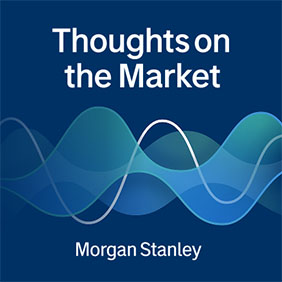More Confidence in a Bull Market
November 3, 2025
Our CIO and Chief U.S. Equity Strategist Mike Wilson looks at buying opportunities approaching year-end, as U.S. trade policy and the Fed find middle ground.

-
 Mike Wilson
Mike Wilson
Thoughts on the Market
Listen to our financial podcast, featuring perspectives from leaders within Morgan Stanley and their perspectives on the forces shaping markets today.

Up Next
How Japan’s Stablecoin Could Reshape Global Finance
Transcript
Welcome to Thoughts on the Market. I’m Mia Nagasaka, Head of Japan Financials Research at Morgan Stanley MUFG Securities.
Today – Japan’s stablecoin revolution and why it matters to global investors.
It’s Friday, October 31st, at 4pm in Tokyo.
Japan may be late to the crypto market. But its first yen-denominated stablecoin is just around the corner. And it has the potential to quietly reshape how digital money moves across the country and globally.
You may have heard of digital money like Bitcoin. It’s significantly more volatile than traditional financial assets like stocks and bonds. Stablecoins are different. They are digital currencies designed to maintain a stable value by being pegged to assets such as the yen or U.S. dollar.
And in June 2023, Japan amended its Payment Services Acts to create a legal framework for stablecoins. Market participants in Japan and abroad are watching closely whether the JPY stablecoin can establish itself as a major global digital currency, such as Tether.
Stablecoins promise to make payments faster, cheaper, and available 24/7. Japan’s cashless payment ratio jumped from about 30 percent in 2020 to 43 percent in 2024, and there’s still room to grow compared to other countries. The government’s push for fintech and digital payments is accelerating, and stablecoins could be the missing link to a truly digital economy.
Unlike Bitcoin or other cryptocurrencies, stablecoins are designed to suppress price volatility. They’re managed by private companies and backed by assets—think cash, government bonds, or even commodities like gold.stablecoins can make digital payments as reliable as cash, but with the speed and flexibility of the internet.
Japan’s regulatory approach is strict: stablecoins must be 100 percent backed by high-quality, liquid assets, and algorithmic stablecoins are prohibited. Issuers must meet transparency and reserve requirements, and monthly audits are standard. This is similar to new rules in the U.S., EU, and Hong Kong.
What does this mean in practice? Financial institutions are exploring stablecoins for instant payments, asset management, and lending. For example, real-time settlement of stock and bond trades normally take days. These transactions could happen in seconds with stablecoins. They also enable new business models like Banking-as-a-Service and Web3 integration, although regulatory costs and low interest rates remain hurdles for profitability.
Or think about SWIFT transactions, the backbone of international payments. Stablecoins will not replace SWIFT, but they can supplement it. Payments that used to take days can now be completed in seconds, with up to 80 percent lower fees. But trust in issuers and compliance with anti-money laundering rules are critical.
There’s another topic on top of investors’ minds. CBDCs – Central Bank Digital Currencies. Both stablecoins and CBDCs are digital. But digital currencies are issued by central banks and considered legal tender, whereas stablecoins are private-sector innovations.
Japan is the world’s fourth-largest economy and considered a leader in technology. But it takes a cautious approach to financial transformation. It is preparing for a CBDC but hasn’t committed to launching one yet. If and when that happens, stablecoins and CBDCs can coexist, with the digital currency serving as public infrastructure and stablecoins driving innovation.
So, what’s the bottom line? Japan’s stablecoin journey is just beginning, but its impact could ripple across payments, asset management, and even global finance.
Thanks for listening. If you enjoy the show, please leave us a review wherever you listen and share Thoughts on the Market with a friend or colleague today.

Why Shutdown Standoff Raises Stakes for Healthcare
Transcript
Ariana Salvatore: Welcome to Thoughts on the Market. I'm Ariana Salvatore, Morgan Stanley's U.S. Public Policy Strategist.
Erin Wright: And I'm Erin Wright, U.S. Healthcare Services Analyst.
Ariana Salvatore: Today we'll talk about what the U.S. government shutdown means for healthcare.
It's Thursday, October 30th at 12pm in New York.
Thus far, it seems like markets haven't really been paying too much attention to the government shutdown.
Obviously, we're aware of the cumulative economic impact that builds every week that it lasts. But we haven't seen any movement from the political front either this week or last, which signals that it could be going on for a while longer. That being said, the end of this month is an important catalyst for a few reasons.
First of all, you have the potential rollover of SNAP benefits. You have another potential missed military paycheck. And most importantly, the open enrollment period for healthcare plans. Polling is still showing neither side coming out on top with a clear advantage.
Absent that changing, you probably need to see one of two things happen to have any movement forward on this front. Either more direct involvement from President Trump as he wraps up the APEC meeting or some sort of exogenous economic event, like a strike from air traffic controllers.
Those types of events obviously are difficult to predict this far in advance. But up until now we know that President Trump has not really been involved in the debate. And the FAA seems to be operating a little bit with delays, but as usual.
So, Erin, let's pivot to what's topical in here. From a healthcare policy perspective, what are investors that you speak with paying the most attention to?
Erin Wright: You bring up some important points Ariana. But from a policy perspective, it's very much an always top of mind for healthcare investors here. Right now, it is a key negotiating factor when it comes to the government shutdown.
So, the shutdown debate is predominantly centered around the Affordable Care Act or the healthcare exchanges. This was a part of Obamacare. It was a program where individuals can purchase standalone health insurance through an exchange marketplace.
The program has been wildly popular; in recent years with 24 million members. Growing 30 per cent last year, particularly with enhanced subsidies that are being offered today. So those subsidies are expected to expire at the end of this year, and those exchange members could be left with some real sticker shock – especially when we're going to see premium increases that could, on average, increase about 25 to 30 percent, in some states even more.
So, folks are really starting to see that now. November 1st will be a key date here as open enrollment period begins ends.
Ariana Salvatore: Right. So, as you mentioned, this is pretty key to the entire shutdown debate. Republicans are in favor of letting the expanded subsidies roll off. Democrats want to restore them to that COVID level enhancement. Of course, there's probably some middle path here, and we have seen some background reporting indicating that lawmakers are talking about a potential middle path or concession. ,
So, talk me through what's on the table in terms of negotiating a potential compromise or extension of these subsidies.
Erin Wright: So, we could see a permutation of outcomes here. Maybe we don't get a full extension, but we could see something partial come through. We could see something in terms of income caps, which restrict kind of the level of participants in the AC exchanges. You could see out-of-pocket minimums, which would eliminate some of those shadow members that we've been seeing and have been problematic across the space. And then you could also grandfather in some existing members that get subsidies today.
So, all of those could offer some degrees of positive and some degrees of relief when it comes to broader healthcare services, when it comes to insurance companies, when it comes to others that are participating in this program, as well as the individuals in themselves. So, it's really a patient dynamic that's getting real here.
A lot is on the table, but a lot is at stake with the potential for the sunsetting of these subsidies to drive 4 million in uninsured lives. So, it is meaningful, and I think that that's something we have to kind of put into perspective here.
So, would love to know Ariana though, beyond healthcare, what are some of those key debates in terms of the negotiations around the shutdown?
Ariana Salvatore: Healthcare really is central to this debate. So aside from just the ACA subsidies that we talked about, some Democrats have also been pushing for a repeal or rollback of some of the pieces of the One Big Beautiful Bill Act that passed earlier this year. That was the fiscal bill of Republicans – passed through reconciliation process – that included some cuts to Medicaid down the line. So, there's been talk around that front.
I think more of a clear path on the subsidies front, because that seems to be something that Republicans are treating as an absolute no-go. Some of the other really key debates are around just kind of how to keep the ball rolling while we're still in the shutdown.
So, I mentioned SNAP at first, the potential release of some contingency funds there. Again, the military paychecks are really critical. And, of course, what this all means for incoming data, which is really important – not just for investors but also for the Fed, as it kind of calibrate[s] their next move. In particular, as we head into the December meeting, I think we got a little bit of a hawkish surprise in yesterday's meeting, and that's something that investors were not expecting.
So, obviously the longer that this goes on, the more those risks just continue to grow, and this deadline that we're talking about is a really critical one. It's coming up soon, so we should have a sense of how our prognosis pans out in the coming days.
Thanks for the conversation, Erin.
Erin Wright: Great talking to you, Ariana.
Ariana Salvatore: And to our audience, thanks for listening. Let us know what you think by leaving us a review wherever you listen. And if you like Thoughts on the Market, tell a friend or colleague about the podcast today.

Sign up to get Morgan Stanley Ideas delivered to your inbox.
Thank You for Subscribing!
Would you like to help us improve our coverage of topics that might interest you? Tell us about yourself.



